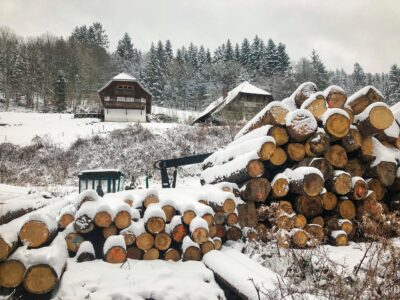Contacts noted prices had risen for kiln-dried lumber as recently as March compared to a year ago for Basswood, Red Oak, Hard and Soft Maple. The species that were reported to be doing well during early spring were Hard and Soft Maple, White Oak and Walnut. Aspen, Basswood, Beech, and to a latter extent Birch were said to not be performing as well.
Lack of supply for certain species is driving demand for Soft and Hard Maple rather than a robust demand. Walnut and White Oak were said to have a solid consumer driven push. Thus, prices are rising for these. Prices, meanwhile, are heading down noted contacts, for Aspen, Beech and Basswood. Cabinet manufacturers were utilizing MDF instead of hardwoods, and not the only sector either reported to be using alternative materials. Industrial markets appear to be faring better. The pallet and container industry are absorbing cant production.
Aspen sales are rather lackluster. Sawmills are not processing this species as much as a result, and supplies are still sufficient to meet market demand.
Ash demand appears to be steady, but at a slow pace. Exports were down slightly compared to 2023 rates, with China being the largest export market, and Canada increasing its imports of this species by 1 percent from the U.S. No. 1 Common and Better grades’ inventories, which are thin due to demand. Kiln-dried prices are noted to be firming up.
Basswood for most suppliers and wholesalers is only being purchased on a replacement basis, and export markets are not great either. Business for No. 1 Common and No. 2A is much slower than for the upper grades, noted some contacts.
Certain wholesalers and secondary manufacturers have been increasing their inventories, and with the Hard Maple production gains, it was easier to do so. As we approach warmer weather, businesses are concerned about the risk of staining. Prices have risen over time for green stock. Kiln-dried inventories are reported as low, particularly for the upper grades.
Sales for Soft Maple remained strong, although not as strong now as earlier this year, and developing supplies increased, easing price pressures for green stock. Soft Maple needs are more balanced.
Color sorted Birch has been selling well since there was a shortage of Maple. Off-colors, however, are challenging to sell. Prices are based on color, sorts, width and lengths, noted contacts.
Beech has been directly affected by domestic secondary manufacturers using more MDF, plywood, and non-wood materials instead. Production is exceeding demand, resulting in downward price pressure.
With the priority to produce Whitewoods over other species less susceptible to stain, Red Oak is sufficient to meet demand. Demand is for the No. 1 Common and Better grades rather than for No. 2A and No. 3A. Kiln-dried inventories are reported to be thin.
There is strong competition for White Oak logs which is limiting available volume for certain mills to process. Green lumber production is low, and demand for No. 1 Common and Better is strong, while decent from other grades. Kiln-dried inventories are noted as thin for all grades. Domestic and overseas markets are solid.
The National Wood Flooring Association Expo provided an opportunity for those in the hardwood flooring industry, from manufacturers, distributors, to dealers and installers, to meet and discuss their concerns about the direction of business for hardwood flooring. They, too, as most hardwood businesses, have issues and concerns about risks to lumber supplies and its health, and the erosion of market share by competition from other products, from engineered flooring to tiles, ceramics, plastics and more. Production efficiencies are a top priority for all to remain in business, as is being able to sell their products. Despite all these issues, there are signs of improved activity for Oak strip flooring sales, as well as of opportunities for wood flooring moving forward.
On April 16 the Liberal government delivered its federal budget, with a focus on housing and homes. Finance Minister Crystia Freeland said, “We are moving with purpose to help build more homes, faster. We are making life cost less. We are driving the kind of economic growth that will ensure every generation of Canadians can reach their full potential.”
Net new spending in this budget is at $39.2 billion. It promises to build 3.87 million new homes by 2031 – two million more than the current expected pace – with measures and funding to scale up the pace of new home construction.
It makes more federal land available for homebuilding and accelerate flows of workers into the construction industry, and announces changes for hopeful homebuyers. First-time homebuyers purchasing new builds can extend their mortgage amortizations to 30 years, up from the traditional 25, and raises the limit for withdrawals via the RRSP Home Buyers’ Plan to $60,000, an increase from $35,000.
It plans to introduce a Canadian Renters’ Bill of Rights to crack down on “unfair practices” in the rental market and changes that would see monthly rent payments count towards building a credit score, as a way to “restore generational fairness in the housing market for younger Canadians.”
Economists say the “ambitious” efforts to rapidly increase housing supply in Canada could give the government a “fighting shot” at eventually restoring affordability, but would not provide a short-term fix for those who are currently boxed out of the housing market. As to making it easier for Canadians to make a down payment and afford monthly mortgage costs, these changes could inadvertently drive home values higher by growing the pool of buyers vying for the low supply in the market.
For students, it extends an existing increase in loans and grants available for an additional year. It also proposes to create a new youth mental health fund of $500 million.
One way government plans to pay for new spending is with revenues tied to changes to how capital gains are taxed.
The budget proposes raising the inclusion rate on returns from sales to two-thirds, up from the current regime of 50 percent, for any individual’s gains that exceed $250,000. For corporations and trusts, the 66.7 percent inclusion rate would apply to all capital gains for tax purposes. It is expected an additional $18 billion in tax revenues over the next six years will be generated from these capital gains changes.
Capital investment in Canada is already low, say economists, and timing of hiking capital gains tax could discourage businesses from putting more money into the economy at a time when growth is already stagnant. Lack of business investment can bring down productivity growth and overall quality of living standards in Canada.
The budget expects that the annual rate of inflation, which ticked up 0.1 percentage point to 2.9 percent in March, is expected to decline back to the Bank of Canada’s 2 percent target by the end of 2024.
While some price pressures showed signs of easing and the Bank of Canada has opened the door to possible interest rate cuts in the months ahead, high shelter costs are what most Canadians are facing. Reining in inflation and setting the stage for rate cuts is therefore a significant way to make life more affordable, say economists.









